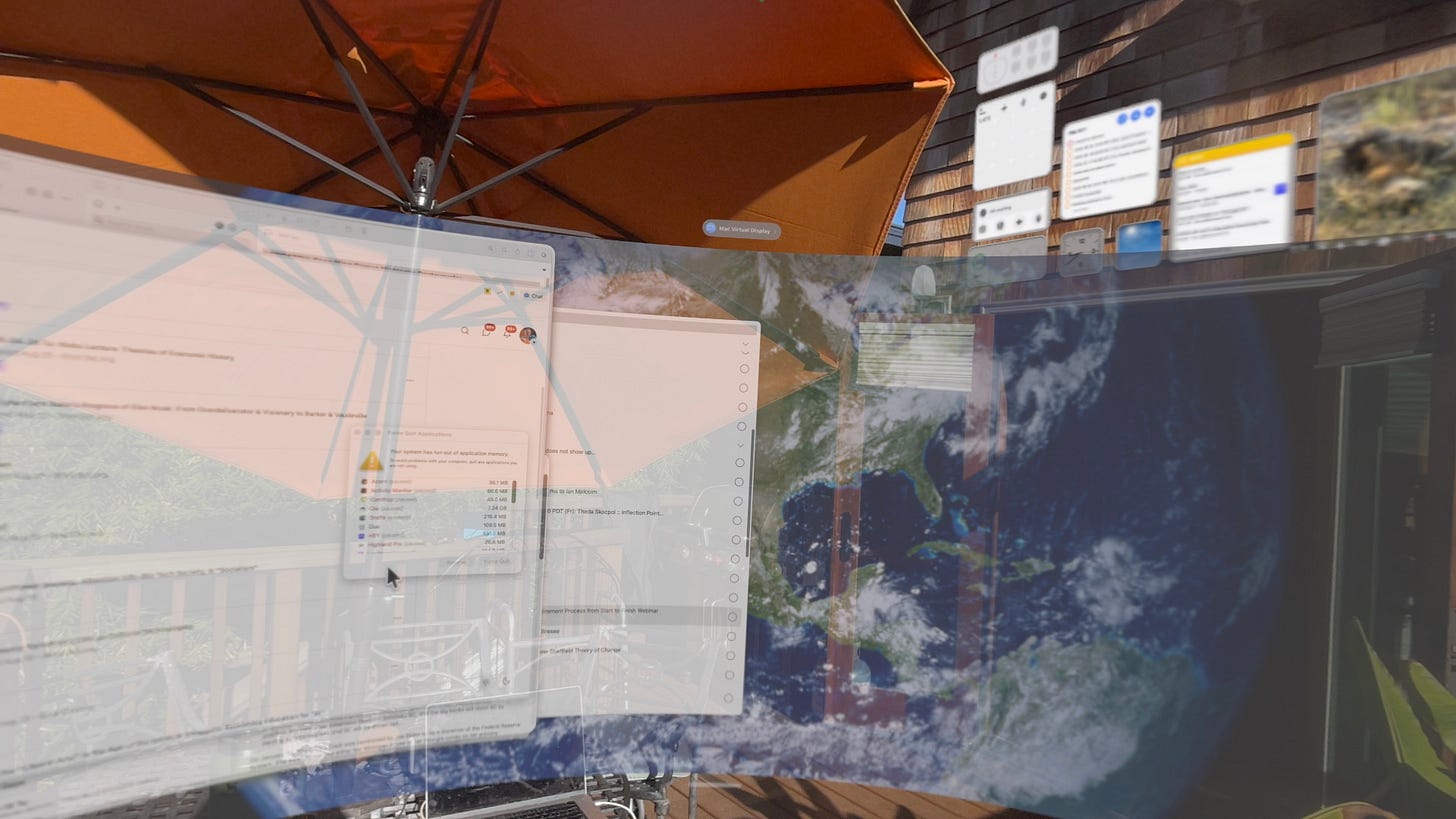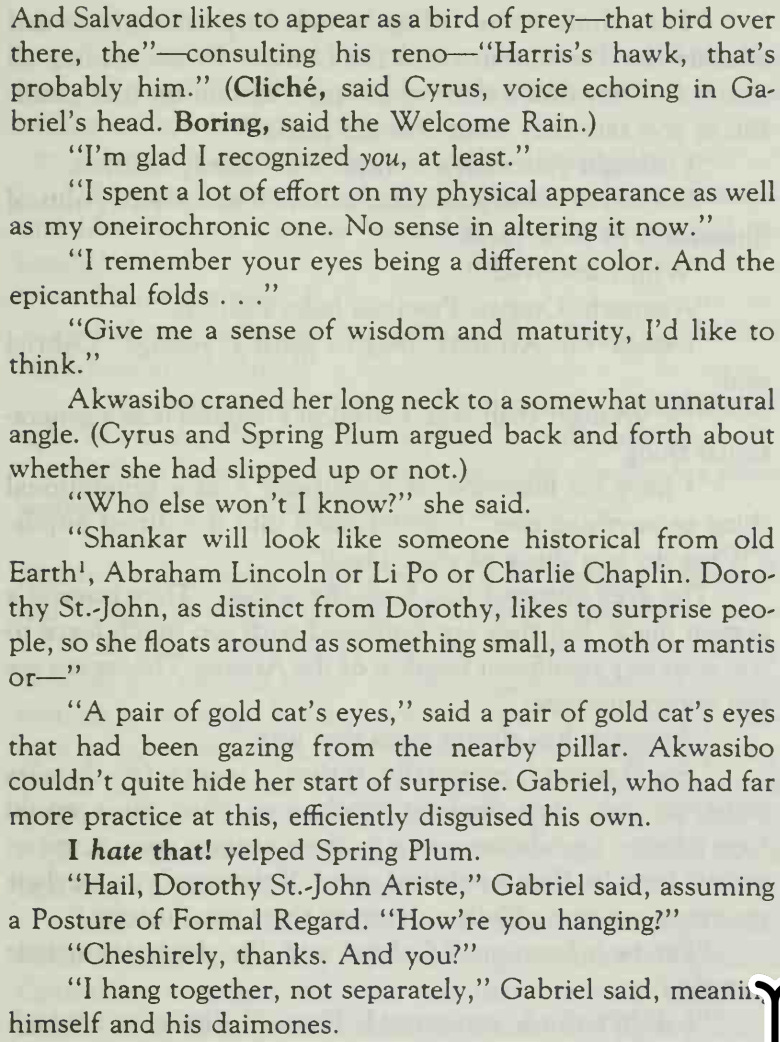On the Apple Vision Pro: Gonzo Tech Demo? Yes...
…Glimpse of the Future? Maybe; Useful Niche Product? Only for a Very Small Nice That Does Not Include Me. Spatial Computing, Virtual Disappointments, and the Search for Real Usefulness: A Brief AVP Diary: Scott Cunningham Swears by Apple’s Vision Pro—But I’m Not Convinced as Back Pain Leads to Beta Testing the Reality of Today’s Virtuality Technology
Encouraged by what I read of the experiences of Scott Cunningham, and noticing the price of $2000 for a used one—three Oculus Quest 3s, but also 25 million pixels in your field of view, which is three Oculus Quest 3s—I have been experimenting with the Apple Vision Pro as something to do when my back does not feel like sitting in front of my 15 million-pixel ASD.
It is approaching genuine usefulness, if your eyes and brain are wired so that they accommodate it, rather than getting either a headache or a freaking out “I must have been poisoned and need to vomit it up now!” reaction”. But, for me, not yet. Probably not quite yet, I think.
But, in my view at least, it is not quite there. Give it a little more effective virtual object permanence and a faster processor, I at least will find it truly useful for more than watching videos and for being on airplanes in economy.
For Scott Cunningham it started relatively early: spring of 2024:
Scott Cunningham: My Review of the Apple Vision Pro After One Month <https://causalinf.substack.com/p/my-review-of-the-apple-vision-pro>: ‘I have used it daily… [as] a substitute… phone, a complement to my laptop, and… a substitute…television…. This European trip w[as]… designed for it… I needed to write… but struggled… distracted… beautiful locations…. Valuable… [as] it transforms confined spaces like airplanes, small Airbnbs, and hotel rooms into massive spaces. It allows me to set up my laptop and project large displays around me…
Back up: The Apple Vision Pro is not the Augmented Reality (AR) device of the future.
It is not a pair of unobtrusive glasses adding fixed-in-visual-space digital information to the world in which you live.
The Apple VisionPro is, rather, a gonzo technology demonstration built by crazed engineers. “We cannot (yet) build the unobtrusive AR glasses of the future”, they thought. “What we can do is build a simulation of those AR glasses. What we cn do is to strap two iPad-micros to your face, and enclose them in a giant pair of unattractive ski goggles.
“So let’s do that instead!
“And then let us tell people that they should pretend that they are a pair of unobtrusive AR glasses, and that they should wear them..”
The point, as I understood it, of the Apple VisionPro was that it was a heavy $3500 VR headset that simulated the light sub-$1000 AR glasses that Apple really wanted but did not yet know how to build. But, Apple decided, real artists ship. Hence sell the VisionPro with as many of the capabilities of the future glasses as possible in order to get people started on building out software to figure out what the use cases for the product we think that ultimately we really want will be. And that process is now, creakily, moving forward.
Then Apple dropped the ball—or, rather, dropped a gross of eggs on the floor. Rather than pushing money through the system in order to get as much in the way of programs and immersive videos onto the platform as possible, 98% of which would be crap but 2% of which would be golden, they carefully polished and repolished and rerepolished and rererepolished so that Apple published an average of about two minutes of new AR or VR content a day, while they sat back and waited for developers and videographers to spend their own money doing things for the VisionPro. Which did not happen. Hence an expensive misfire. And, at best, a technology demonstration that is still several bridges too far.
So we are still light-years away from the vision (ha! ha!) of Neuromancer, let alone the totally gonzo Aristoi:
Walter John Williams: Aristoi <https://en.wikipedia.org/wiki/Aristoi_(novel)>: ‘Persepolis, in the Realized World, was an interesting artifact… the (largely symbolic) capital…. ‘Persepolis’, the dream, was a far more interesting place…. The two cities superimposed on one another in ways both intricate and obscure…. Archons and senators strolled along the corridors, holding conversations with people others could not see. Corridors that dead-ended in reality possessed doors… [which] led to palaces, dominions, grottos, and fantasies that did not exist anywhere…. ‘Who else won’t I know?’ she said. “Shankar will look like someone historical from old Earth, Abraham Lincoln or Li Po or Charlie Chaplin. Dorothy St.-Jean… likes to surprise people… something small, a moth or a mantis or—’ ‘A pair of gold cat’s eyes’, said a pair of gold cat’s eyes that had been gazing from the nearby pillar…
(Not to mention we do not have the -way internal parallel processing as you spin-up different Turing-Class Aspects of yourself and run them simultaneously on separate partitions of your wetware:
Walter John Williams Aristoi <https://en.wikipedia.org/wiki/Aristoi_(novel):
And I have not been impressed by other technology demonstrations FaceBook and Google have been doing. Thus I think that this from Mark Gurman is largely wrong:
Mark Gurman: Meta CTO Sees New AR Glasses As Game Changing <https://www.bloomberg.com/news/newsletters/2024-09-29/meta-steps-up-pressure-on-apple-vision-with-orion-ar-glasses-and-cheaper-quest-3-m1nkq76p?cmpid=BBD092924_POWERON>: ‘Meta’s masterstroke was the demonstration of its Orion AR glasses prototype… the closest thing we’ve seen to a pair of practical AR spectacles.… a product category that could transform the way people use technology…
FaceBook has built 1000 prototype models of the Orion AR glasses that it could not sell for less than $20,000 each. It is not selling these demonstration prototypes as products. It appears to have released this technology demonstration for two reasons:
first, to reassure shareholders that the money Mark Zuckerberg has poured into the Metaverse has not been completely wasted;
second, to light a fire underneath the Facebook teams working in the VR/AR space so that they actually ship something more than an Oculus gaming headset.
Will it become a product in two or five years? Perhaps. If it does become a product, As I see it, Facebook will have to get you to buy a neurolink wristband, a computer for your pocket, and the glasses. When Apple wants to match, all it will have to do is sell you the glasses—at least to those of us who already have Apple Watches on our wrists and Apple iPhones in our pockets. But this doesn’t mean that FaceBook is behind in any sense in the VR space. The case for VR for gaming is clear—and FaceBook is way ahead. The case for VR for immersive experiences is clear—but Apple has not delivered with more than an eyedropper. And this does not mean that the Apple VisionPro is not gonzo insane.
Yet, Scott Cunningham—proprietor of <http://causalinf.substack.com>—is all-in, finding that the VisionPro is, for him, not merely useful but transformative. “LIFE CHANGING,” he writes, with sincerity, not irony.
And so the natural question becomes: Why?
And the second question is: Since I have a very unhappy back these days and want to work, will this thing allow me to have a bigger effective screen than a laptop when I am lying on the floor, relaxing my back on the couch, outside keeping the dogs from barking at the squirrels, and at the standing desk? I mean, having the ASD screen available only about one hour in five I spend working is not good. And carrying the ASD screen from place to place as I change back position is asking for yet another very expensive episode of my-life-as-a-sitcom.
Which is to say that, encouraged by the example of Scott, I have spent August so far going all-in not just on The Browser Company’s AI-copilot browser Dia, but also on the AVP.
Some preliminary conclusions so far, valid for me (and perhaps only me):
Apple’s Claims About the Value & Usefulness of “Spatial Computing” Are Bull***t: Apple claims, stridently, that the VisionPro is not like an Oculus—not a VR or an AR or even an MR (Mixed Reality) or XR (Extended Reality) device. Apple claims, stridently, that it is rather an SC—a Spatial Computing—device.
That is bull***t.
It is a VR—a fully immersive digital environment replacing the real world—device that emulates AR—overlaying digital content onto the real world—because its IDE including a not-quite-good-enough exterior camera view of your surroundings as one of the elements in its IDE VR space.
It has next to nothing of MR in it.
“SC” would be the interface we see Tom Cruise using in the movie Minority Report, in which windows float in space, fingers become cursors, rooms become boundless, and computing becomes ubiquitous and ambient as you move through the world living your life. That would be Mark Weiser’s dream <https://web.archive.org/web/20130509053627/http://www.ubiq.com/hypertext/weiser/NomadicInteractive/Sld001.htm> realized. The Apple VisionPro is not that.
But Utility for Scott: So how does Scott find a VR device that simulates AR useful? He lays out five conditions that he sees as together sufficient to find the VisionPro very useful: (1) You work all day at a computer. (2) Your computer is not in an open-plan office filled with people but in your private single-person office. (3) You care deeply about large monitors. (4) You travel frequently. (5) You really love immersive entertainment and very large screens. Miss any one of those, he says, and the utility drops off a cliff. Miss two, and you are back in Oculus Quest territory: It becomes an intriguing device gathering dust inside a closet. For Scott, there is also (6) the fact that he is distractible, and hence a device that is antisocial by design, that is a retreat, not a companion in today’s information-overload feed-based social-media world. For him that antisocial nature that critics see as a flaw is an impprtant feature. Focus. Remove distractions. Escape social media. The Vision Pro is not alienating—it is liberating.
He claims to use it up to 10 hours a day, often swapping out batteries mid-session. For him, this is not gadgetry. This is workflow architecture.
Now, let’s return to the original question: Why is Scott Cunningham one of the only people who finds this device not just dazzling but profoundly useful?
Because the Vision Pro is a niche technology—but a niche that happens to map perfectly onto his lifestyle.
How About for Me?: Is It Worth the $2000?
Maybe.
But probably not.
I would say the odds are 65-35 that after Labor Day this thing will start gathering dust in the closet, or be sent back to eBay. I am close enough that I do think that, for me, the odds would be in this thing’s favor had Apple made a real software-and-content push, rather than waiting for a developer community that is now deeply, deeply hostile to and suspicious of Apple management to rush in with serious resources.
But while I satisfy Scott’s (1 all-day), (2 private-office), (3 large-monitor), and (5 love large immersive); but not, these days at least, (4 travel) and (6 distraction-free). And it is not quite enough that I do have: (7) a back that thinks it was a huge mistake to come down from the trees and shift it from a horizontal to a vertical orientation.
If I had (4 travel) heavily in the mix, that might push it over the edge: Remember: I did try it on my trip to teh La the Apple VisionPro again on airplanes and in hotel rooms has been a real eye-opener (ha ha!). It now has three enormously advantageous use cases:
Immersive Video: Is absolutely amazing. The problem is that there is so little of it.
Psychological Isolation is useful on more-than-four-hour economy-class airplane flights.
Big Screen is for me an effective substitute for my ASD.
But I am not there. In sum, the Apple Vision Pro sits at the crossroads of technological ambition and practical disappointment, promising a future of boundless digital space but delivering mostly polished constraint. The device excels at immersive video and creating psychological elbow room, yet falters with scarce content and nonexistent MR. For the rare user, it’s desireable workflow architecture incarnate. For the rest, those who search for bicycles for the mind, it’s a reminder that the future arrives first as a not-there prototype, and that many futures prototyped never arrive at all.
References:
Clover, Juli. 2024. "Apple Seeds Third Beta of visionOS 2.2 to Developers With Ultrawide Mac Virtual Display." MacRumors. November 18. <https://www.macrumors.com/2024/11/18/apple-releases-visionos-2-2-beta-3/>.
Cunningham, Scott. 2024. Rant in Defense of the Apple Vision Pro. November 14. <https://causalinf.substack.com/p/rant-in-defense-of-the-apple-vision>.
Cunningham, Scott. 2024. CodeChella Madrid, My Summer Plans in Europe, and a Video Review of My New Apple Vision Pro. May 8. <https://causalinf.substack.com/p/summer-plans-in-europe-review-of>.
Cunningham, Scott. 2024. Why Is TWFE Biased in Some Event Study Graphs but Not Others? (with an Apple Vision Pro Explainer at the End). May 9. <https://causalinf.substack.com/p/why-is-twfe-biased-in-some-event>.
DeLong, J. Bradford, Andrei Shleifer, Lawrence H. Summers, & Robert J. Waldmann. 1990. "Noise Trader Risk in Financial Markets." Journal of Political Economy. 98 (4): 703–738. <https://www.jstor.org/stable/2937765>.
Gibson, William. 1984. Neuromancer. New York: Ace. <https://archive.org/details/Timothy_Leary_Archives_206.dv>.
Gurman, Mark. 2024. "The Vision Pro's first killer app has arrived". Bloomberg Power On. November 10. <https://www.bloomberg.com/news/newsletters/2024-11-10/apple-s-expansion-plan-glasses-home-devices-mixed-reality-headsets-airpods-m3bncxeo>.
Patel, Nilay. 2024. "Apple Vision Pro Review: Magic, Until It’s Not." The Verge. January 30. <https://www.theverge.com/24054862/apple-vision-pro-review-vr-ar-headset-features-price>.
Shleifer, Andrei, & Lawrence H. Summers. 1990. "The Noise Trader Approach to Finance." Journal of Economic Perspectives. 4 (2): 19–33. <https://www.jstor.org/stable/1942888>.
Shleifer, Andrei, & Robert W. Vishny. 1997. "The Limits of Arbitrage." The Journal of Finance. 52 (1): 35–55. <https://pages.stern.nyu.edu/~cedmond/phd/Shleifer%20Vishny%20JF%201997.pdf>.
Weiser, Mark. 1991. “The Computer for the 21st Century.” Scientific American 265, no. 3 (September): 94–104. <https://web.archive.org/web/20130509053627/http://www.ubiq.com/hypertext/weiser/NomadicInteractive/Sld001.htm>.
Williams, Walter Jon. 1992. Aristoi. New York: Tor Books. <https://en.wikipedia.org/wiki/Aristoi_(novel)>.
If reading this gets you Value Above Replacement, then become a free subscriber to this newsletter. And forward it! And if your VAR from this newsletter is in the three digits or more each year, please become a paid subscriber! I am trying to make you readers—and myself—smarter. Please tell me if I succeed, or how I fail…




